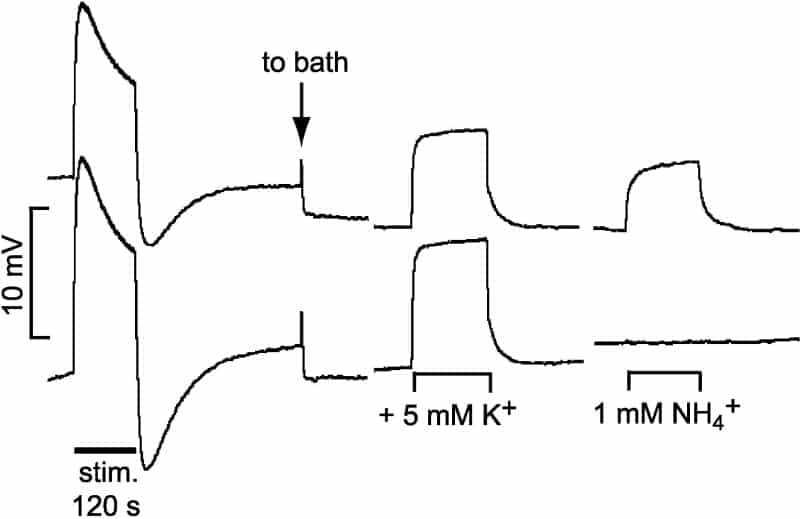Expression of mRNA coding for putative ammonium transporters is widespread, but the functions of ammonium transporters have been little studied except in plant roots and kidneys (Ludwig et al, 2004). Glial cells of the compound eye of the bee take up NH4+ by cotransport with Cl– (Marcaggi & Coles, 2000). It has been proposed that the neurons of bee retina (which are all photoreceptors) are provided by the glial cells with alanine as their major energy substrate (Tsacopoulos et al, 1994). Conversion of alanine to pyruvate releases ammonium, which may return to the glial cells. To test this proposal, I used ion-selective microelectrodes to measure [NH4+] in the interstitium of slices of drone retina superfused with (mM) NaCl, 205; KCl, 10; MgCl2, 4; CaCl2, 2; MOPS, 10; sucrose, 240; pH 6.90. One barrel of the electrode contained an ‘ammonium’ sensor sensitive to both NH4+ and K+(Bührer et al 1988), one barrel contained a K+ sensor based on valinomycin, and the third barrel measured the electrical potential; the total tip diameter was 3 – 4 μm. When the photoreceptors were stimulated with a train of light flashes, there was a large K+ signal: to extract the much smaller NH4+ signal, I calibrated the electrode immediately after any measurement (Fig. 1). With the standard superfusate solution, interstitial [NH4+] was not detected even at the end of 120s light stimulation (mean, 0.072 mM; SEM, 0.091 mM, n = 9). When superfusate Cl– was replaced by glucuronate and gluconate, interstitial [NH4+] was detectable: 0.290 ± 0.089 mM (n = 10; P by Student’s t test < 0.01) in the dark; 0.41± 0.12 mM after 120s light stimulation (n = 9). Since removal of Cl– blocks uptake of NH4+ into the glial cells, these results suggest that the NH4+-Cl– cotransporter normally aids the flow of ammonium from the neurons to the glia. Inclusion of 25 mM alanine in the superfusate significantly reduced the variance of the [NH4+] measurements (P = 0.0009 with Cl–, and P = 0.011 without) but did not change the mean values. When 10 mM Na pyruvate was substituted for 10 mM Na glucuronate in the 0 Cl– superfusate, [NH4+] at the end of the stimulation was reduced to 0.04±0.10 mM (n = 5, P < 0.002) apparently without loss of neuronal function.
King's College London (2005) J Physiol 565P, C59
Communications: The glial NH4+ -Cl- cotransporter facilitates the neuron-glia ammonium flux in bee retinae
Coles, Jonathan A;
1. Universit├® Joseph Fourier/INSERM U594, Grenoble, France.
View other abstracts by:
Fig. 1 Potentials (reference subtracted) of the 'ammonium' barrel (top) and the K barrel (bottom) in a slice superfused with 0 Cl- solution. Light stimulation for 120s transiently increased both signals. The electrode was then calibrated in 0 Cl- solutions responses to two solutions being shown. The gaps in the record correspond to 1.75 and 1.35 ks.
Where applicable, experiments conform with Society ethical requirements.

